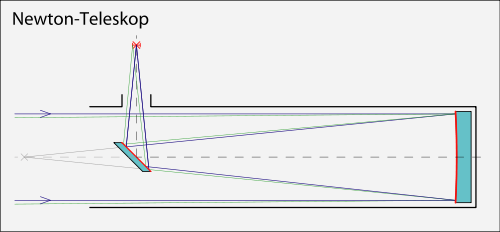Newtonian telescope is a kind of reflecting telescope that has a concave primary mirror and a flat secondary mirror. It is patterned after the telescope invented by Sir Isaac Newton, the famous British astronomer and scientist who during the 17th century. Sir Newton first invented this kind of telescope in 1668. His telescope had a simple yet functional design. Today, the Newtonian telescope is still very popular; it is not very hard to make, and therefore not as expensive as other, more sophisticated kinds of telescope.
In Newton’s time, there were already telescopes in use, but they were refracting ones, not the reflecting kind. They were not very effective because, due to the principle of refraction, they caused colors and images to become distorted. This phenomenon is called chromatic aberration, and Newton thought it could be eliminated if a telescope employed the principles of reflection instead of refraction. And so, using his knowledge of optics, mirrors and the color spectrum, and drawing upon earlier ideas put forth by scientists like Galileo Galilei and Giovanni Francesco Sagredo, Newton was able to produce the first reflecting telescope.
The first Newtonian telescope did not use any lens. Instead, it used mirrors that were shaped and ground to form an optical surface. It was revolutionary in that it used a secondary mirror that was diagonally mounted to reflect the image from the primary mirror at a precise ninety-degree angle. Because of this, the reflection had minimal obstruction and no chromatic aberration.
The telescope was a success. It could see as far as the moons of Jupiter. The invention earned Newton his admittance into the elite Royal Society of London.
Newtonian Telescope

